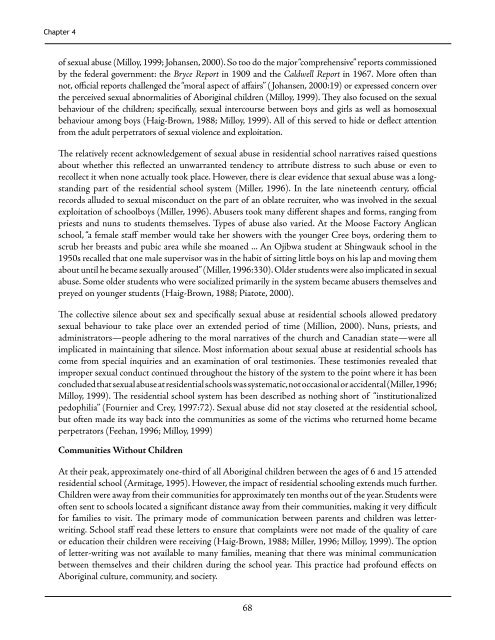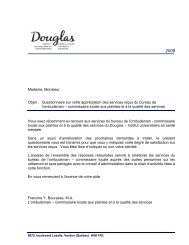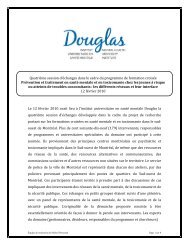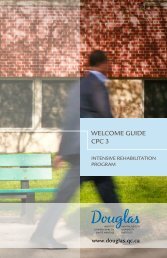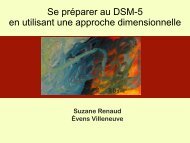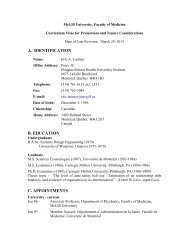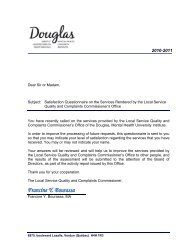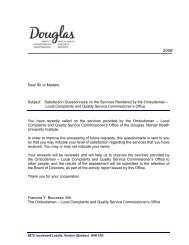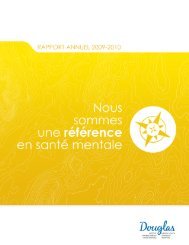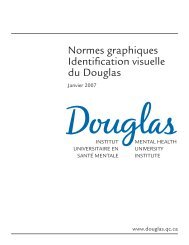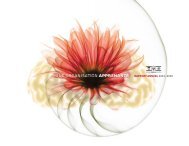Chapter 4Duncan Campbell Scott, Deputy Super<strong>in</strong>tendent of Indian Affairs, proclaimed that it was the right andduty of the Canadian federal government to protect <strong>Aborig<strong>in</strong>al</strong> children aga<strong>in</strong>st ill-treatment (Milloy,1999). Despite this, there were no formal guidel<strong>in</strong>es outl<strong>in</strong><strong>in</strong>g the range of discipl<strong>in</strong>e permitted, andcorporal punishment rema<strong>in</strong>ed a dom<strong>in</strong>ant practice with<strong>in</strong> the walls of the residential school (Miller,1996; Milloy, 1999).In 1921, a visit<strong>in</strong>g nurse at Crowstand School discovered n<strong>in</strong>e children “cha<strong>in</strong>ed to thebenches” <strong>in</strong> the d<strong>in</strong><strong>in</strong>g room, one of them “marked badly by a strap.” Children werefrequently beaten severely with whips, rods, and fists, cha<strong>in</strong>ed and shackled, bound handand foot and locked <strong>in</strong> closets, basements and bathrooms ( Johansen, 2000:18).Incidents of this sort were not isolated, and were normally left unattended by the Department ofIndian Affairs. There were several reasons for the hesitancy of the federal government to deal with suchmatters—some government officials were wary of church <strong>in</strong>fluence, while others sought to conceal theharsh treatment of <strong>Aborig<strong>in</strong>al</strong> children <strong>in</strong> the government records (Satzewich and Mahood, 1995). Theresidential school system was supposed to be evidence that the federal government was carry<strong>in</strong>g outits obligations to <strong>Aborig<strong>in</strong>al</strong> people as wards of the Canadian state accord<strong>in</strong>g to the Indian Act. Thus,it was imperative that the real conditions of the schools did not reach the Canadian public or, <strong>in</strong> morecontemporary times, the <strong>in</strong>ternational community.The explicit <strong>in</strong>tent of punishment was to cause pa<strong>in</strong> and humiliation to underm<strong>in</strong>e the oppositional selfand force subjugation to the ideology of the school (Graham, 1997). Public humiliation is recalled as oneof the most terrible experiences by residential school Survivors (Grant, 1996; Graham, 1997). For example,upon arriv<strong>in</strong>g at residential schools, children were given severe haircuts and issued numbers that were usedto identify them ( Johnston, 1988; Haig-Brown, 1988; Knockwood, 1992; Armitage, 1995; Miller, 1996;Graham, 1997; Milloy, 1999). In many <strong>Aborig<strong>in</strong>al</strong> cultures there was great symbolism attached to thehair; hence, the shear<strong>in</strong>g of hair was a cause of great shame. This ritual constituted a direct assault onand negation of <strong>Aborig<strong>in</strong>al</strong> cultural values (Grant, 1996). At some schools, such as the Mohawk <strong>Institut</strong>eResidential School and Mount Elg<strong>in</strong> Indian Residential School (both <strong>in</strong> Ontario), abuse was so frequentthat students were classified based on the number of punishments they received and the reasons why theyreceived them (Graham, 1997).It was the professional responsibility of Indian agents to evaluate the conditions under which the students<strong>in</strong> their charge were liv<strong>in</strong>g and learn<strong>in</strong>g. Indian agents had the power to recommend the dismissal ofunsatisfactory teachers, pr<strong>in</strong>ciples, and staff to the Department of Indian Affairs, as well as the power todischarge students. The federal archives are peppered with negative reports filed by former Indian agentsattest<strong>in</strong>g to the cruel and <strong>in</strong>humane conditions at many residential schools (Satzewich and Mahood,1995; Milloy, 1999; Johansen, 2000). Unfortunately, there is little <strong>in</strong>dication that Indian agents <strong>in</strong>vokedtheir power to protect students with any regularity.Sexual Abuse <strong>in</strong> Residential SchoolsAlthough the exact number will probably never be known, a significant number of former residential schoolstudents endured sexual abuse (Haig-Brown, 1988; Knockwood, 1992; Miller, 1996; Grant, 1996; Fournierand Crey, 1997; Milloy, 1999; Johansen, 2000; Million, 2000). While the Canadian archives conta<strong>in</strong> recordsof physical abuse filed by former Indian agents and government officials, official files virtually ignore the issue67
Chapter 4of sexual abuse (Milloy, 1999; Johansen, 2000). So too do the major “comprehensive” reports commissionedby the federal government: the Bryce Report <strong>in</strong> 1909 and the Caldwell Report <strong>in</strong> 1967. More often thannot, official reports challenged the “moral aspect of affairs” ( Johansen, 2000:19) or expressed concern overthe perceived sexual abnormalities of <strong>Aborig<strong>in</strong>al</strong> children (Milloy, 1999). They also focused on the sexualbehaviour of the children; specifically, sexual <strong>in</strong>tercourse between boys and girls as well as homosexualbehaviour among boys (Haig-Brown, 1988; Milloy, 1999). All of this served to hide or deflect attentionfrom the adult perpetrators of sexual violence and exploitation.The relatively recent acknowledgement of sexual abuse <strong>in</strong> residential school narratives raised questionsabout whether this reflected an unwarranted tendency to attribute distress to such abuse or even torecollect it when none actually took place. However, there is clear evidence that sexual abuse was a longstand<strong>in</strong>gpart of the residential school system (Miller, 1996). In the late n<strong>in</strong>eteenth century, officialrecords alluded to sexual misconduct on the part of an oblate recruiter, who was <strong>in</strong>volved <strong>in</strong> the sexualexploitation of schoolboys (Miller, 1996). Abusers took many different shapes and forms, rang<strong>in</strong>g frompriests and nuns to students themselves. Types of abuse also varied. At the Moose Factory Anglicanschool, “a female staff member would take her showers with the younger Cree boys, order<strong>in</strong>g them toscrub her breasts and pubic area while she moaned ... An Ojibwa student at Sh<strong>in</strong>gwauk school <strong>in</strong> the1950s recalled that one male supervisor was <strong>in</strong> the habit of sitt<strong>in</strong>g little boys on his lap and mov<strong>in</strong>g themabout until he became sexually aroused” (Miller, 1996:330). Older students were also implicated <strong>in</strong> sexualabuse. Some older students who were socialized primarily <strong>in</strong> the system became abusers themselves andpreyed on younger students (Haig-Brown, 1988; Piatote, 2000).The collective silence about sex and specifically sexual abuse at residential schools allowed predatorysexual behaviour to take place over an extended period of time (Million, 2000). Nuns, priests, andadm<strong>in</strong>istrators—people adher<strong>in</strong>g to the moral narratives of the church and Canadian state—were allimplicated <strong>in</strong> ma<strong>in</strong>ta<strong>in</strong><strong>in</strong>g that silence. Most <strong>in</strong>formation about sexual abuse at residential schools hascome from special <strong>in</strong>quiries and an exam<strong>in</strong>ation of oral testimonies. These testimonies revealed thatimproper sexual conduct cont<strong>in</strong>ued throughout the history of the system to the po<strong>in</strong>t where it has beenconcluded that sexual abuse at residential schools was systematic, not occasional or accidental (Miller, 1996;Milloy, 1999). The residential school system has been described as noth<strong>in</strong>g short of “<strong>in</strong>stitutionalizedpedophilia” (Fournier and Crey, 1997:72). Sexual abuse did not stay closeted at the residential school,but often made its way back <strong>in</strong>to the communities as some of the victims who returned home becameperpetrators (Feehan, 1996; Milloy, 1999)Communities Without ChildrenAt their peak, approximately one-third of all <strong>Aborig<strong>in</strong>al</strong> children between the ages of 6 and 15 attendedresidential school (Armitage, 1995). However, the impact of residential school<strong>in</strong>g extends much further.Children were away from their communities for approximately ten months out of the year. Students wereoften sent to schools located a significant distance away from their communities, mak<strong>in</strong>g it very difficultfor families to visit. The primary mode of communication between parents and children was letterwrit<strong>in</strong>g.School staff read these letters to ensure that compla<strong>in</strong>ts were not made of the quality of careor education their children were receiv<strong>in</strong>g (Haig-Brown, 1988; Miller, 1996; Milloy, 1999). The optionof letter-writ<strong>in</strong>g was not available to many families, mean<strong>in</strong>g that there was m<strong>in</strong>imal communicationbetween themselves and their children dur<strong>in</strong>g the school year. This practice had profound effects on<strong>Aborig<strong>in</strong>al</strong> culture, community, and society.68
- Page 1 and 2:
Suicide Among Aboriginal Peoplein C
- Page 3 and 4:
Aboriginal Healing Foundation75 Alb
- Page 6 and 7:
Table of ContentsPreface...........
- Page 8 and 9:
Table of ContentsCultural and Lingu
- Page 10:
PrefaceThis report was prepared und
- Page 14 and 15:
GlossaryAmbivalence - Ambivalence r
- Page 16 and 17:
GlossaryParasuicide - Any acute, in
- Page 18 and 19:
Chapter 1IntroductionWhen I was 14
- Page 20 and 21:
Chapter 1Definitions of Suicide and
- Page 22 and 23:
Chapter 1Methods of Studying Suicid
- Page 24 and 25:
Chapter 1suicide attempts (Marttune
- Page 26 and 27:
Chapter 1A central problem for cros
- Page 28 and 29:
Chapter 2The Epidemiology of Suicid
- Page 30 and 31:
Chapter 2the economic status of Abo
- Page 32 and 33:
Chapter 2No study to date has syste
- Page 34 and 35: Chapter 2Despite the overall patter
- Page 36 and 37: Chapter 2Figure 2-6) Average Annual
- Page 38 and 39: Chapter 2are only a portion of thos
- Page 40 and 41: Chapter 2Figure 2-9) Suicide Rates
- Page 42 and 43: Chapter 2Indeed, the rising rate of
- Page 44 and 45: Chapter 2Figure 2-11) Number of Dea
- Page 46 and 47: Chapter 2Rate per 100,000 populatio
- Page 48 and 49: Chapter 2There are only a handful o
- Page 50 and 51: Chapter 3Origins of Suicide: Indivi
- Page 52 and 53: Chapter 3Anxiety disorders also car
- Page 54 and 55: Chapter 3Many of the factors associ
- Page 56 and 57: Chapter 3American Indians compared
- Page 58 and 59: Chapter 3genetic and constitutional
- Page 60 and 61: Chapter 3Single-parent families are
- Page 62 and 63: Chapter 3Hopelessness, Problem Solv
- Page 64 and 65: Chapter 3higher rates of suicidal b
- Page 66 and 67: Chapter 3Physical EnvironmentSuicid
- Page 68 and 69: Chapter 31990; Chandler, 1994). Thi
- Page 70 and 71: Chapter 3Risk FactorsDepressionSubs
- Page 72 and 73: Chapter 4Origins of Suicide: Social
- Page 74 and 75: Chapter 4Reserves, Settlements, and
- Page 76 and 77: Chapter 4Traditionalism versus accu
- Page 78 and 79: Chapter 4are equivalent in seriousn
- Page 80 and 81: Chapter 4society (Levy and Kunitz,
- Page 82 and 83: Chapter 4those of mother and homema
- Page 86 and 87: Chapter 4Traditional Aboriginal com
- Page 88 and 89: Chapter 4Feehan, 1996; Grant, 1996;
- Page 90 and 91: Chapter 4The Child Welfare System a
- Page 92 and 93: Chapter 4Aboriginal communities and
- Page 94 and 95: Chapter 4had extremely high rates.
- Page 96 and 97: Chapter 4Figure 4-2) Transgeneratio
- Page 98 and 99: Chapter 5What Works in Suicide Prev
- Page 100 and 101: Chapter 5Table 5-1) Strategies of I
- Page 102 and 103: Chapter 5Effective Suicide Preventi
- Page 104 and 105: Chapter 5closet rods that give way
- Page 106 and 107: Chapter 5The American Indian Life S
- Page 108 and 109: Chapter 51) school-based and commun
- Page 110 and 111: Chapter 5reduce suicides that follo
- Page 112 and 113: Chapter 5Although they may visit a
- Page 114 and 115: Chapter 6Conclusion: Understanding
- Page 116 and 117: Chapter 6Figure 6-1) An Integrative
- Page 118 and 119: Chapter 6in large urban settings th
- Page 120 and 121: Chapter 6there’s like a program s
- Page 122 and 123: Chapter 6Figure 6-2) Levels of Inte
- Page 124 and 125: Chapter 6Planning and CoordinationA
- Page 126 and 127: Chapter 62) The response to the cri
- Page 128: Chapter 6Often, suicide is a respon
- Page 131 and 132: Appendix AASIST participants receiv
- Page 133 and 134: Appendix AThe Training for Youth Ed
- Page 135 and 136:
Appendix AThe program has continued
- Page 137 and 138:
Appendix Awith the creation and imp
- Page 139 and 140:
Appendix AContact Information for R
- Page 142 and 143:
Appendix BAdditional Resources: Man
- Page 144:
Appendix BAboriginal Healing and We
- Page 147 and 148:
Appendix CNational Aboriginal Healt
- Page 149 and 150:
References——— (1987). Unravel
- Page 151 and 152:
ReferencesBeck, A.T., R.A. Steer, M
- Page 153 and 154:
ReferencesBrent, D.A., J.A. Perper,
- Page 155 and 156:
References——— (1995). The Pro
- Page 157 and 158:
ReferencesDevereux, G. (1961). Moha
- Page 159 and 160:
References——— (2005b). In wha
- Page 161 and 162:
ReferencesGardiner, H. and B. Gaida
- Page 163 and 164:
ReferencesGuo, B. and C. Harstall (
- Page 165 and 166:
ReferencesHoberman, H.M. and B.D. G
- Page 167 and 168:
ReferencesJong, M. (2004). Managing
- Page 169 and 170:
ReferencesKouri, R. (2003). Persona
- Page 171 and 172:
References——— (1997). Suicide
- Page 173 and 174:
ReferencesMatheson, L. (1996). The
- Page 175 and 176:
ReferencesNeimeyer, R.A., B. Fortne
- Page 177 and 178:
ReferencesPirkis, J.E., C.E. Irwin,
- Page 179 and 180:
ReferencesRutz, W. (2001). Preventi
- Page 181 and 182:
References——— (1992). Marriag
- Page 183 and 184:
ReferencesTrimble, J. and B. Medici
- Page 185 and 186:
ReferencesWebb, J.P. and W. Willard


